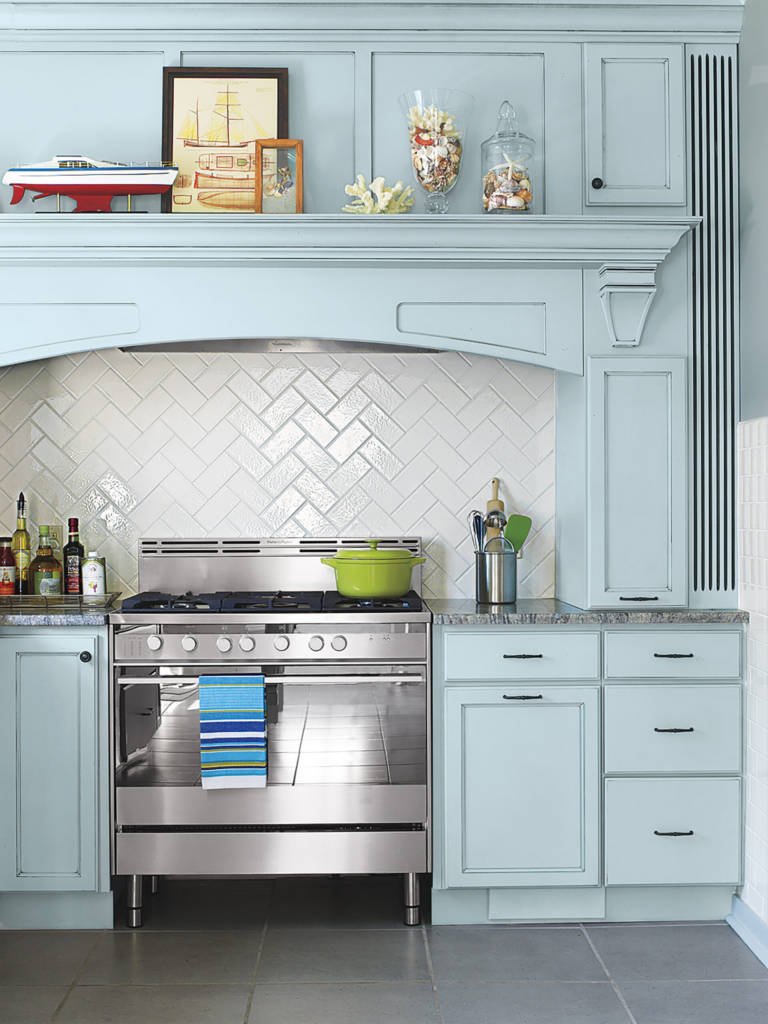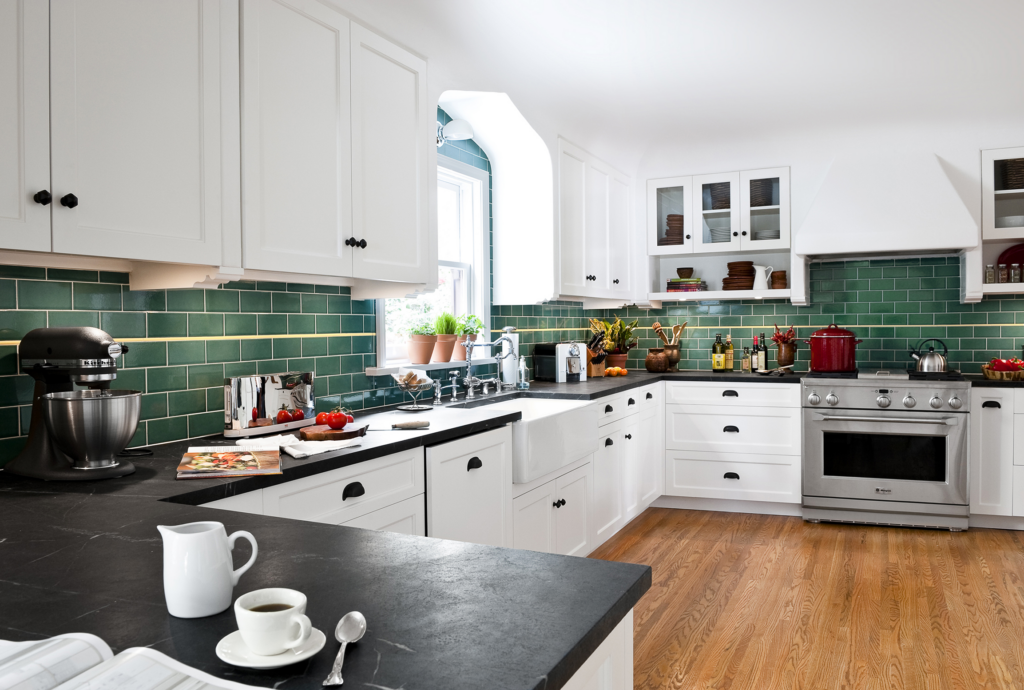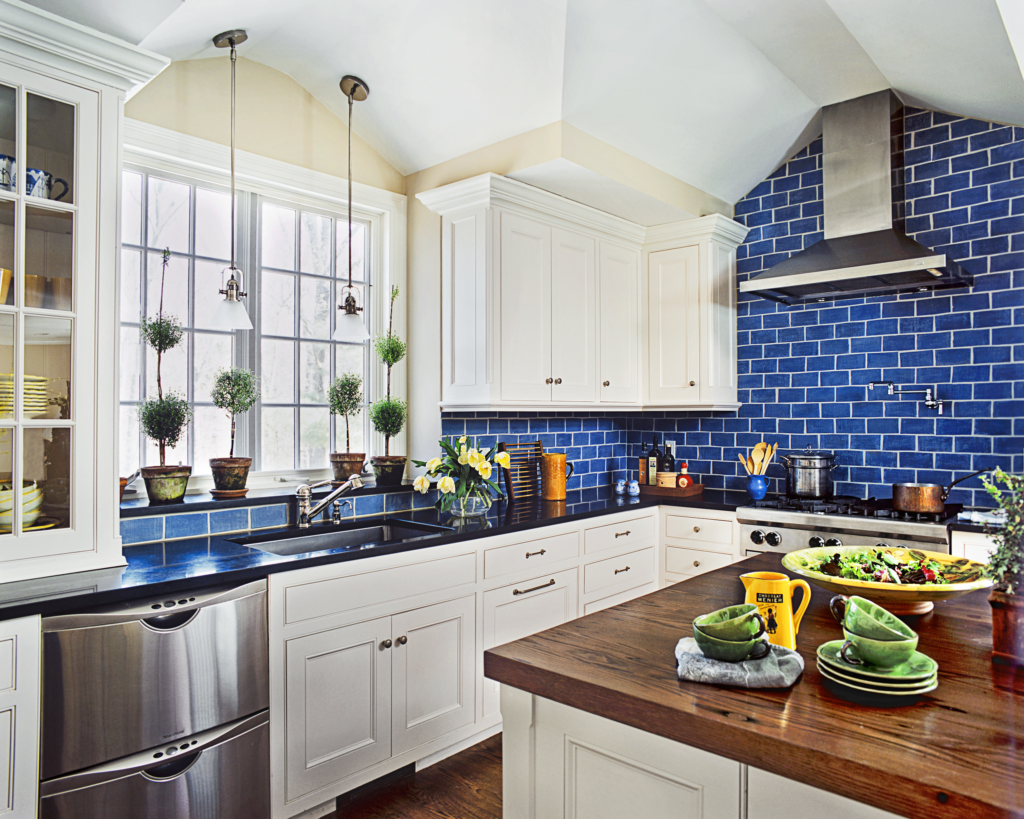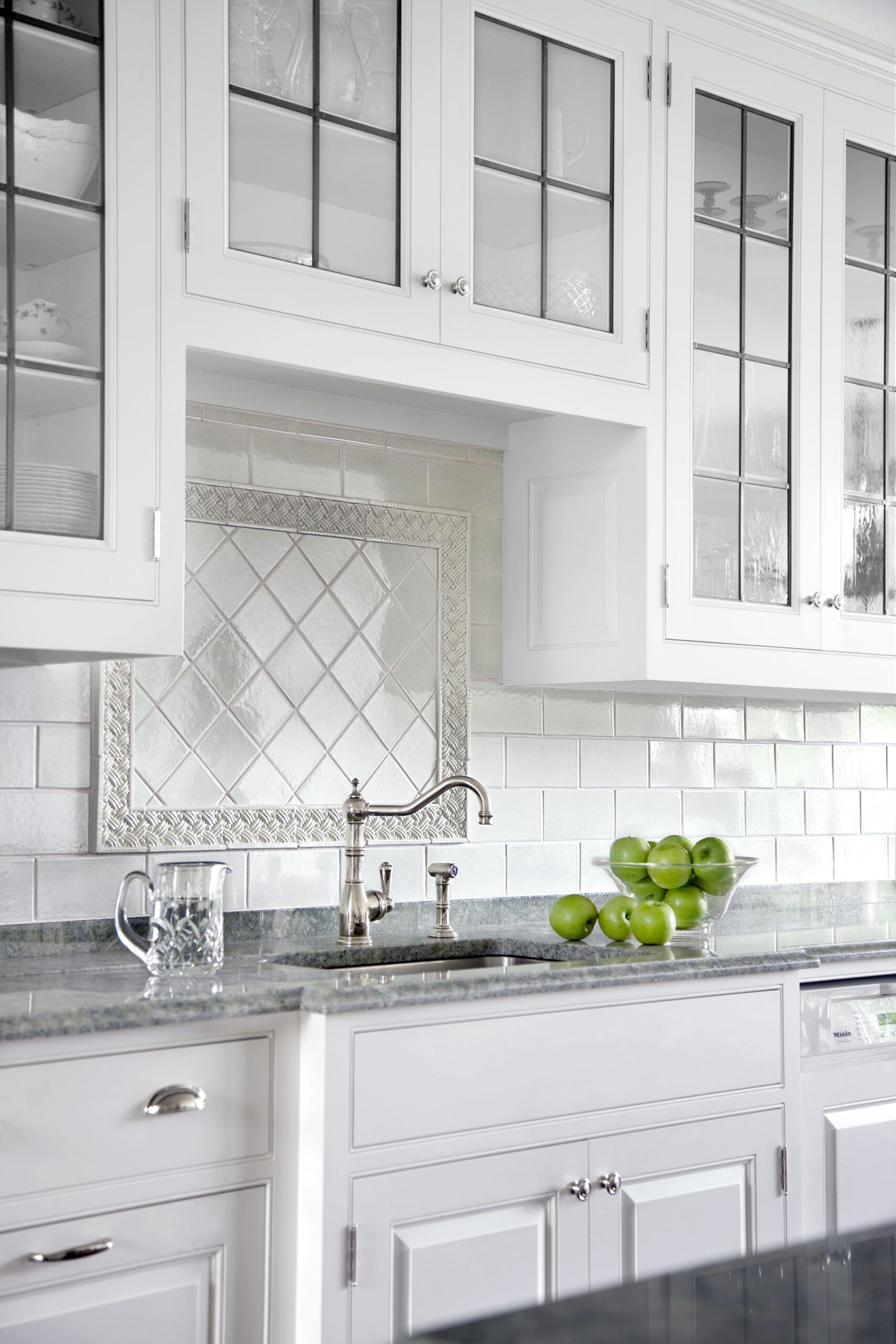As a staple of kitchen and bath design, the ubiquitous ceramic subway tile has been around since it was introduced in New York City’s subway stations in the early 1900s. The easy-to-clean, stain-resistant, light-reflective, 3-by-6-inch glazed white rectangles captured the public’s imagination back then and quickly moved into the bathrooms and kitchens of prewar houses for practical and aesthetic reasons.
More than a century later, ceramic subway tile still endures as a perennial favorite for homeowners. Today’s tiles come in a mind-boggling array of colors and finishes that partner well with just about any style of decor. And they’ve made the leap from kitchens and baths to other hardworking spaces that benefit from easy-care surfaces, such as laundry rooms, mudrooms, and fireplace surrounds.
Inevitably, the popularity of subway tile has expanded its working definition. Manufacturers often use the term now to describe any rectangular tile with a length twice its height, from 4-by-8-inch planks to 1-by-2 mosaics, and even some tiles (such as contemporary 2-by-8 strips) that don’t share the original’s proportions at all.
They’re tough enough to withstand decades of abuse—in fact, the adhesive, grout, and caulk used to install them will likely need replacing long before the tiles do.
Types of Subway Tiles
Ceramic subway tiles come in various types, each offering unique characteristics and aesthetic appeal. Below, we’ll highlight some popular styles.
Traditional Ceramic Subway Tiles
Traditional ceramic subway tiles are mass-produced and offer a consistent look and feel. They typically feature a uniform size and shape and a smooth, glazed surface. These tiles are ideal for those seeking a classic, clean look in their kitchens or bathrooms. They’re durable, easy to clean, and can last a long time, making them a practical choice for high-traffic areas.
Handmade Artisan Subway Tiles
Handmade artisan subway tiles are an excellent option for a more unique and rustic appearance. Slight variations in size and shape, textured surfaces, unique glazes and finishes, and a higher price point characterize these tiles. Handmade tiles add character and depth to a space, with each tile being slightly different from the next. They’re perfect for creating a focal point or adding a touch of artisanal craftsmanship to your design.
Contemporary Variations
Modern manufacturing techniques have led to a variety of contemporary subway tile options. These include large format tiles, such as 4×8 inches or larger, and unique shapes like elongated hexagons. Additionally, textured surfaces mimic natural materials and metallic and iridescent finishes. These contemporary variations allow for more creative and personalized designs, pushing the boundaries of traditional subway tile aesthetics while maintaining the classic rectangular shape.
Subway Tile Patterns

The layout of subway tiles can significantly impact your project’s final appearance. Consider these popular patterns when designing your project.
Classic Running Bond
A running bond pattern is the most traditional layout for subway tiles. In this style, tiles are laid end to end, with joints in each row centered on the tiles in adjacent rows. This creates a classic, timeless look and is forgiving of slightly out-of-square walls. Depending on the chosen tile color and finish, the running bond pattern works well in traditional and contemporary settings.
Basketweave Design
For a unique and intricate look, consider trying the basketweave pattern by alternating vertical and horizontal tiles. This pattern adds texture and interest to large surfaces. You may also want to incorporate this design with contrasting grout colors to highlight it.
Herringbone Pattern
For a more dynamic and eye-catching design, consider the herringbone pattern. This layout uses tiles at 45-degree angles to create a zigzag effect. This pattern adds visual interest and can make a space feel larger. It works particularly well as a backsplash or feature wall, transforming even simple white tiles into a striking design element.
Vertical Stacking
With a vertical stack, tiles are stacked vertically with joints aligned, creating a sleek, contemporary look. Vertical stacking can make ceilings appear higher and is particularly effective in small spaces like powder rooms.
Subway Tile Finishes and Edge Styles
Your subway tile’s finish and edge style can dramatically affect its overall appearance and how it interacts with light in your space. Here’s an overview of popular options.
- Glazed finishes: These are the most common for ceramic subway tiles. They offer a smooth, glossy surface that’s easy to clean and provides excellent stain and moisture resistance. Some glazed finishes feature subtle tonal variations or crackle effects, adding depth and character to the tile’s appearance.
- Matte and textured finishes: Matte finishes provide a soft, non-reflective surface, while textured finishes can mimic natural materials like stone or wood. These finishes are less likely to show water spots or fingerprints and can add depth and interest to monochromatic designs.
- Edge variations: The edge style of your subway tile can subtly influence the overall look. Square edges offer a clean, modern look, while rounded edges, or “shoulders,” provide a softer appearance. Beveled edges, where the sides slope away from the face, give each tile a sculptural quality. Pillowed edges feature a slightly raised center, adding dimension to the tile surface.
How Grout Impacts Subway Tiles
The color and width of your grout lines can significantly alter the appearance of your tiled surface. Here are some ways you can integrate grout into your subway tile design.
Contrasting Grout Colors
Contrasting grout colors can create a bold, graphic effect. Using dark grout with light tiles highlights the tile pattern, adding drama and definition to a simple tile layout. Additionally, contrasting grout can be more forgiving in high-traffic areas, as it’s less likely to show dirt.
Matching Grout Colors
Selecting a grout color that closely matches your tile produces a seamless look and minimizes visible grout lines. This matching approach enhances intricate tile patterns and creates a monochromatic, cohesive appearance, particularly effective in smaller spaces. Light-colored grout that complements the tile further amplifies this effect, resulting in an elegant and unified design.
Grout Width
When choosing your grout width, consider both aesthetic preferences and practical concerns. For example, wider grout lines can be easier to clean and maintain in high-moisture areas like showers. The width of your grout lines also affects the overall appearance: narrow grout lines (1/16 inch or less) create a more seamless look, while wider grout lines (1/8 inch or more) emphasize the tile pattern.
Subway Tile in Different Rooms

Ceramic subway tile is versatile enough to work in various rooms throughout the home. Here’s how it can be used effectively in different spaces.
Kitchen Applications
Homeowners frequently use subway tile for kitchen backsplashes, but it also works well in other areas, including range hoods, island facades, or full-wall applications. By using border pieces to set off a smaller field of different tiles, you can create a framed focal point above the sink or cooktop. This technique draws attention to key areas of your kitchen design.
Bathroom Designs
Bathrooms are another popular area for subway tile applications, such as shower walls, bathroom surrounds, or wainscoting. You can also use smaller subway tiles for non-slip shower floors. A popular bathroom design often features brightly colored or glossy white subway tiles finished with a contrasting black base and a chair rail or bullnose cap, creating a classic and practical look.
Other Living Spaces
Consider subway tiles in other areas of your home, including fireplace surrounds, laundry rooms, and mudrooms. When using subway tile in living spaces, consider more subtle colors or unique patterns to create a softer, more inviting atmosphere.
Pros and Cons of Ceramic Subway Tile
Before choosing ceramic subway tile for your project, weigh the pros and cons of your specific needs and preferences.
Pros
- Cost-effective: Basic subway tiles are relatively affordable compared to many other tile options.
- Durable: Ceramic tiles are tough and can last for decades with proper care.
- Easy to maintain: Glazed ceramic tiles are easy to clean and resist stains.
- Light reflective: Light-colored subway tiles can help brighten up a space.
- Timeless appeal: These tiles offer a classic look that has been popular for more than a century.
- Versatile: Subway tiles work well in various design styles, from traditional to modern.
Cons
- Cold underfoot: Ceramic tiles can feel cold, which might be a concern in bathrooms or bedrooms.
- Requires grout maintenance: Grout lines can be prone to staining and may require regular cleaning and sealing.
- Installation challenges: Proper installation requires skill and patience, especially for complex patterns.
- Limited texture options: While available in various colors and finishes, ceramic tiles don’t offer the same textural variety as natural stone.
- Potential for a dated look: If not styled carefully, subway tiles can sometimes feel outdated or overly common.
DIY vs Professional Subway Tile Installation
Whether you’re opting for a DIY approach or planning to hire a professional, understanding the basics of tile installation can greatly contribute to a successful project. Below, we’ll cover both installation options to help you make an informed decision.
DIY Installation Guide
For anyone thinking about taking a do-it-yourself (DIY) approach, here’s a brief overview of the tile installation process:
- Prepare the surface: Make sure the backing is stable, rigid, and clean. The substrate might be concrete, plywood, drywall, or cementitious backer board.
- Plan your layout: Measure carefully and plan your tile pattern to avoid awkward cuts in visible areas. Use corner trim or bullnose edges to finish exposed edges.
- Use the right tools: Invest in quality tile cutters, spacers, and a notched trowel for even adhesive application.
- Start with a level line: Use a horizontal level line and a vertical plumb line as guides to ensure straight installation.
- Apply adhesive carefully: Use the correct type of adhesive and apply it evenly with a notched trowel.
- Maintain consistent spacing: Use tile spacers to keep grout lines even.
- Allow proper drying time: Follow manufacturer recommendations for adhesive and grout drying times.
Tiling is a messy job that requires patience and practice. If you are new to tiling, we recommend starting with a small project, such as installing a backsplash.
When To Hire a Professional
Although many homeowners can install subway tile themselves, there are situations in which hiring a professional is advisable. Professional tile installers have the expertise and tools to handle complex installations and ensure a high-quality result. They can also often complete the job more quickly than a DIY approach.
Here are some scenarios when hiring a professional is a better option:
- If you have a complex layout or patterns (like herringbone)
- If the project involves angles or complex cuts
- When you are installing expensive or delicate tiles
- If you’re working on large-scale projects or full-room renovations
- If you’re unsure about waterproofing requirements (especially in bathrooms)
Ceramic Subway Tile Maintenance

Here are some tips for cleaning and caring for your ceramic subway tiles.
- Regular cleaning: Wipe down tiles regularly with a damp cloth or mop using warm water and mild, non-abrasive soap.
- Avoid harsh chemicals: Harsh cleaners damage the glaze on ceramic tiles. We recommend using pH-neutral cleaners designed for tile.
- Avoid abrasive tools: Don’t use scrub brushes or abrasive pads, which can scratch the tile surface.
- Dry after cleaning: Use a soft cloth to dry tiles after cleaning to prevent water spots, especially on glossy finishes.
- Clean spills quickly: Clean up spills immediately to prevent staining, especially on unglazed tiles or light-colored grout.
- Maintain grout: Seal cement-based grouts to prevent staining and moisture penetration. Reapply sealer as recommended by the manufacturer.
- Inspect and repair: Periodically check for loose or cracked tiles and repair them promptly to prevent water damage to the substrate.

